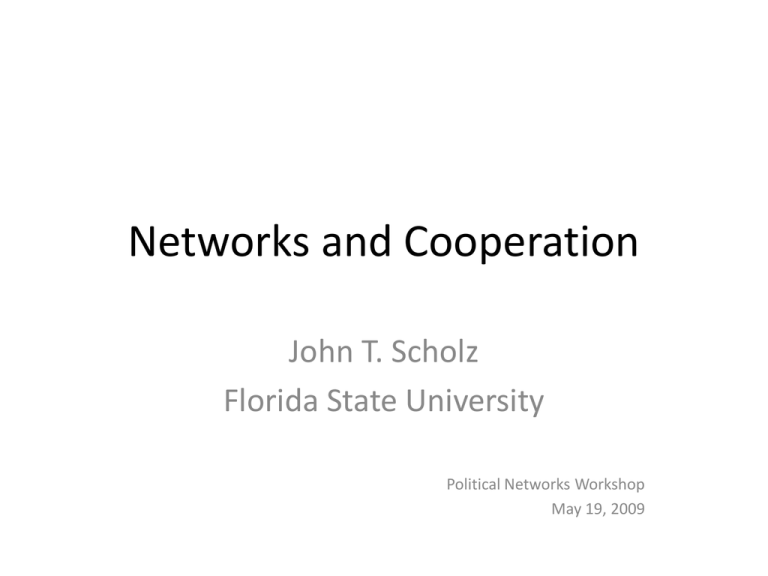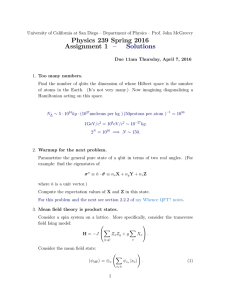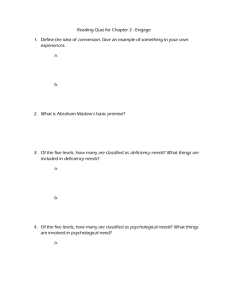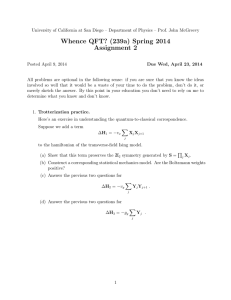Networks and Cooperation John T. Scholz Florida State University Political Networks Workshop
advertisement

Networks and Cooperation
John T. Scholz
Florida State University
Political Networks Workshop
May 19, 2009
Background: Why Networks?
• Local Institutions develop to coordinate policies
where environmental problems are most acute.
– Mark Lubell, John Scholz, Mark Schneider, and Mihriye Mete. 2002.
“Watershed Partnerships and the Emergence of Collective Action Institutions”
American Journal of Political Science 46: 148-163.
• Federal policies can enhance the capacities of local
policy networks to integrate policies within these
institutions
•
Mark Schneider, Mark Lubell, John T. Scholz, Denisa Midruta, and Matt Edwards.
2003. “Building Consensual Institutions: Networks and the National Estuary
Program” American Journal of Political Science 47:143-158.
Background: Why Networks?
• Local institutions and policy networks transform
interests and strongly influence independent
federal policies
– John T. Scholz and Cheng-Lung Wang. 2006. “Cooptation or Transformation?
Local Policy Networks and Federal Regulatory Enforcement” American Journal
of Political Science 50(1): 81-97
Bonding Social Capital
A’s Network Position Measures
Degree
3
Clustering
1
Centrality
0
Bridging Social Capital
B’s Network Position Measures
Degree
3
Clustering
0
Centrality
0.8
The Risk Hypothesis
• Bridging relationships most effective for low
risk coordination/assurance games.
– Efficient information transmission
• Bonding relationships most effective for
higher risk dilemmas, like prisoners dilemmas
– Norms and 3rd party punishment
Two questions for networks
• The impact of networks on cooperative
behavior (performance)
– Network structures and general level of
cooperation
– Network positions and propensity to cooperate.
• The dynamics of network selection in
dilemmas
– When do actors seek bridging, when bonding?
Bridging in Estuary Policy Arenas
• Betweenness centrality of ego, not clustering,
enhances level of collaboration
– John T. Scholz, Ramiro Berardo, and Brad Kile. 2008.“Do Networks Solve
Collective Action Problems? Credibility, Search, and Collaboration” Journal of
Politics 70(2):393-406
• Actors seek central coordinators, not
transitivity
– Different organizations are central
– Indicates dynamic preference for popular actors
– Ramiro Berardo and John T. Scholz, “Self-Organizing Policy Networks: Risk,
Partner Selection and Cooperation in Estuaries” 2009?
Bonding Capital: 3 Studies
• Learning Networks
– Evolution of cooperation on fixed networks
– Agent-based computational model
• Game Networks: Repeated Prisoners Dilemma
– Experiment 1: Network impact on performance:
• Bridging vs Bonding Capital, fixed networks
– Experiment 2: Endogenous networks and
performance
Learning Networks and
Cooperation
• Evolution transforms dilemma into
coordination game of strategy selection
• TFT replaces AllD in finite populations, if
– cooperative payoffs and repetitions before
updating favor cooperation when pTFT>1/3
– : ρ > 1/N >ρ
– ρ depends on
TFT
AllD
• types of strategies (retaliatory, altruistic, exploitative)
• clustering of contact types (replaces N)
• Learning/updating algorithm and learning network
From: Nowak et al. 2004. Emergence of cooperation and evolutionary stability in finite populations
Nature 428: 646-50
Learning Networks and Cooperation
• “Five Rules for the Evolution of Cooperation”
–
–
–
–
–
Kinship
Direct Reciprocity (Repetition)
Indirect Reciprocity (Reputation)
Network Reciprocity (Structure of Relationships)
Group Selection
Martin A. Nowak, 2006; Science 314: 1560
Learning Networks and Cooperation
• Graph game (overlapping k-person public
goods game):
–
–
Cooperators give benefit b to all k neighbors, at cost c
Defectors get benefits, do not give, and incur no cost.
• Selection favors Cooperation if
b/c > k
(Ohtsuki et al Nature 2006)
Learning Networks and Cooperation
• Fixed game structure (10 regulators play all firms)
• Vary learning structures
• Ring, random, small world, and village
• Size: N ={25, 50, 100, 200}
• Connectivity: Degree= {2,4,8} and {5,10}
• Proportionate Learning algorithm
• Copy best response among friends, with innovation
• All 1-period strategies
• Together, they define a Markov chain
• Invariant distribution determines cooperation
Learning Networks and
Cooperation
Learning Networks and
Cooperation
Learning Networks and
Cooperation
Learning Networks and
Cooperation
• Testable Hypotheses: Cooperation increases
with:
– Bridging Capital (faster exploitation of TFT):
• Larger networks (to some threshold)
• More connected (higher degree)
– Bonding Capital (better defense against AllD)
• Higher clustering
– Greatest impact in small, less connected networks
– Particularly effective in concentrated village structure
II. Do Closed Triads Increase
Cooperation?
• Experimental Design
– 66 subjects (in 3 separate sessions)
– complete survey first (measure trust and trusting
behavior)
– assigned randomly in groups of 3
– Play 20 periods of PD (end known in advance)
• Payoffs: 0, 25, 75, 100
– Reassign, repeat for 4 complete rounds of 20
periods each
Treatment: Closed vs Open Triad
Bridging
Open Leader= A
Open Follower = B, C
Bonding
Experimental Design
Logit analysis of cooperation
Variable
Coefficient
Std. Error
Constant:OpenNonleader
0.88
0.19
Closed
0.11
0.07
0.27**
0.10
0.09
0.11
0.07
0.11
Trust Behavior X Closed
0.20**
0.05
T rustEnvironment
0.20**
0.02
Closedfirst
0.00
0.25
round2
0.77*
0.08
round3
0.82*
0.08
round4
0.33*
0.08
Last 3 periods
-1.46
0.07
Open Leader
Trust:
Behavior
Attitude
Predicted Probability of Cooperation
Predicted Probability of Cooperation
Do Closed Triads Increase
Coordination?
• What comparable game can represent the
coordination problem?
– Symmetric: Pick same alternative from multiple
choices
• Follow the leader: Open will coordinate in 2 periods
– Asymmetric:
• Open leader can exploit, but how much?
• Closed will do better if compromise (focal) solution
exists?
III. Do Cooperators Cluster?
Does Clustering Increase
Cooperation
• Market for Lemons:
– Low value exchanges replace high value when
information asymmetry induces opportunism
• Exchange: baubles replace diamonds
• Collaboration: low risk replaces high risk, high gains
– Represented by PD payoffs, where
• CC= high value exchange (diamonds for diamonds)
• DD= low value exchange (glass beads for beads)
• CD, DC = opportunism (beads for diamonds)
Market for Lemons
• Voluntary exchanges:
– Select partner only when both agree
– Execute the exchange
– Drop partner whenever dissatisfied
Lemons Experiment
• 14 subjects per session, computer assisted.
• Subjects propose,
• When proposals match, play pd with each
partner. (Increasing costs for multiple matches)
• Repeat for 20 rounds (known in advance).
• Reputation mechanism manipulation:
– Experiential
– Local
– global
Benchmarks and Conjectures
• Pessimists: Stage game payoff dominant Nash
equilibrium
– 4 links per person, Defect in all games
– Earning: 60.4 ECU’s
• Optimists: Social Optimum
– 10 links per person, Cooperate in all games
– Earning: 393.6 ECU’s.
• Behavioral Conjectures
– Selection: Optimists will cluster
– Influence: Clustered player will learn to cooperate
0.4
50
0.2
100 150 200 250 300
Average Earnings
Baseline
Central
Local
0.6
0.8
Average Earnings
0
0.0
Average % of C Plays
1.0
Average % of C Plays
5
10
15
20
5
10
15
Average # CC Links
Average # of Links
6
4
2
Average # of Links
3
2
0
1
0
Average # CC Links
4
8
Period
5
Period
20
5
10
Period
15
20
5
10
Period
15
20
Optimists Banish Pessimists to
Nashville
• A movie is worth 10000 words
The Optimists’ Advantage
• Optimists play Quit-for-Tat (QFT)
– Voluntary dilemma extension of TFT
– Cooperate with all new links
– Don’t associate with any defectors (cut link)
• In good context (many QFT) optimists cluster
together to trade diamonds, not beads
– all earn socially optimal payoff
• As context deteriorates, QFT becomes more
generous
– Maintain links, play TFT before cutting tie
The Pessimists’ Disadvantage
• Pessimists play Defect, don’t quit (DnoQ)
– Cluster of DnoQ maintains trade in beads, not
diamonds
– Cut off from QnoT at first encounter
– Earn “nash” payoff with lower earning (25 vs 75)
– Supports fewer links (optimal at 4 links)
– Expected payoff per period in experiment
• QFT vs QFT= ???? 100
• DnoQ vs DnoQ= 400
QFT versus DnoQ
Strategy
Number observed
Total Earning
QFT
8
5967
Other
42
3970
DnoQ
6
3276
All
56
4181
Strategies categorized by actions in first 3 periods
Comparison of cooperation decisions
between top and bottom earners
(local)
Cooperate After
Periods 1-3
Periods 15-17
Bottom 25% Top 25%
Bottom 25% Top 25%
No link
0.38
0.92
0.29
0.30
CC
0.69
1.00
0.87
1.00
DD
0.11
0.00
0.08
0.00
CD
0.33
0.71
0.42
0.00
DC
0.33
1.00
0.13
.
Comparison of linking decisions
between top and bottom earners
(local)
Link After
Periods 1-3
Periods 15-17
Bottom 25% Top 25%
Bottom 25% Top 25%
No link
0.36
0.46
0.46
0.15
CC
0.93
0.97
1.00
1.00
DD
0.71
0.75
0.79
0.38
CD
0.64
0.39
0.88
0.33
DC
0.67
0.83
0.89
0.00
Conclusion:
Self-organizing resolution of the
market for lemons
• Optimists ban pessimists to Nashville
– Self-organizing diamond exchange: cooperators
cluster together and earn more.
– Bead exchange banished to “Nashville”.
• Explanation: optimists play QFT and pessimists
play DnoQ.
– Subjects playing QFT earn much more than those
playing DnoQ
– Top earners tend to play QFT




